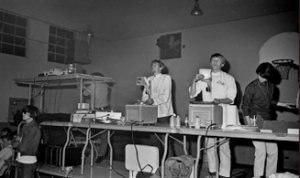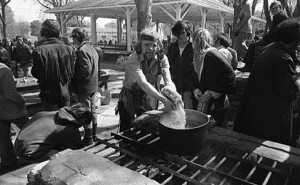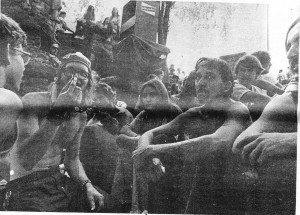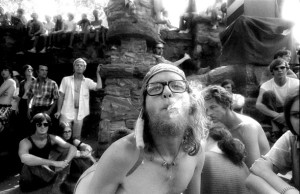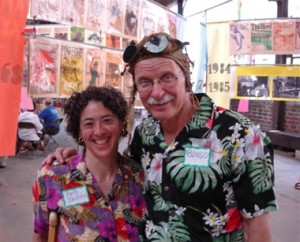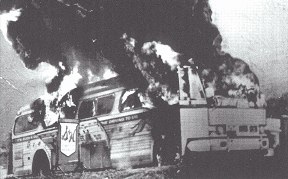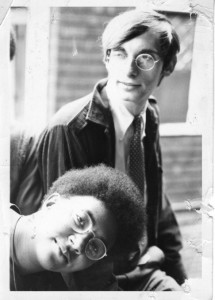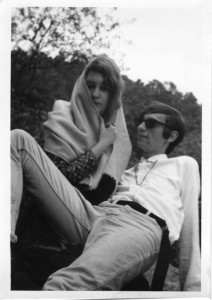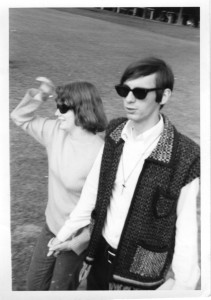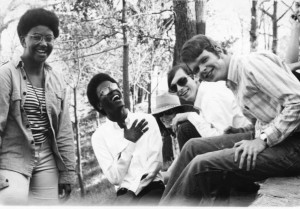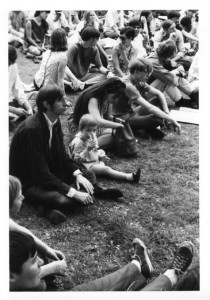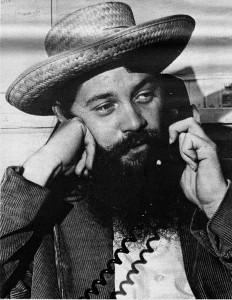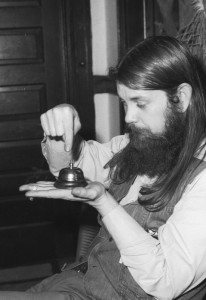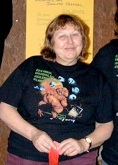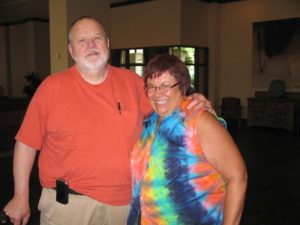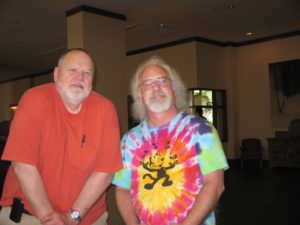http://www.politicalaffairs.net/article/view/3403/1/167
5-10-06, 9:16 am
(APN) ATLANTA – It’s difficult to talk about the leftist scene in Atlanta in the 1960’s and 70’s without someone bringing up The Great Speckled Bird, the leftist alternative newspaper which influenced so many minds of the time. But what was The Bird? Who ran it and how did it operate?
Atlanta Progressive News has conducted extensive interviews and uncovered vast archives of The Bird’s back issues, to explain this historical phenomenon to our progressive readers of today.
In the 1960s, there were 800 underground newspapers in the United States. Many lasted a short time, but for eight and a half years, The Great Speckled Bird told the other side that other Atlanta newspapers were afraid to touch.
In 1971, Mike Wallace of CBS’s “60 Minutes” called The Bird “The Wall Street Journal of the underground press.”
But, what does it mean?
First, the name, The Great Speckled Bird, comes from a country-gospel tune of the same name.
When the initial staff members, who were considering starting an alternative paper, heard this song in 1967, they knew they had a perfect title.
A history of controversy
The first issue came out March 15, 1968 and immediately generated controversy.
The first story was titled, “What’s It All About, Ralphie?,” a eulogy for Atlanta legend and then-publisher of the Atlanta Journal Constitution, Ralph McGill. The article was highly critical of McGill’s advocacy of dropping nuclear bombs on Vietnam.
This would not be the last controversy. On May 26, 1969, The Bird ran a cover that featured a muscular, bearded man holding a large weapon shouting, “C’mon and Get It Motherfuckers” against a Coca-Cola background.
A month later, Atlanta Police arrested then-Business Manager of The Bird Gene Guerrero and three paper vendors for selling obscene literature to minors and violating the city’s profanity ordinance. The charges were later dismissed. When The Bird ran the news, that they had clarified the freedom of the press in Atlanta for everyone, staffers added wittily, “I wondered what made the motherfuckers change their minds?”
The Bird had a habit of criticizing the local establishment, be it the police who harassed local hippies and Bird vendors, real estate developers, or City Hall, especially then-Mayor of Atlanta Sam Massell.
The 1972 Office Firebombing
In May 1972, an unknown assailant(s) firebombed The Bird office at 240 Westminster Drive in the middle of the night.
Most of the house was destroyed along with back issues of the paper and other artifacts. A police report was filed but no arrest was ever made in connection with the crime. Most Atlanta residents denounced the attack.
But like the Phoenix rising from the ashes, The Bird emerged from the fire and continued publishing without missing a beat. Benefit dinners were held and donations were made to help the paper recover.
A Volunteer and Freelance Staff
From 1968 through 1976, things went on this way. The work was hard, the pay was low, and the harassment constant. Staff members came and went, contributing what they could when they could. The Bird retained the sporadic services of various printers willing to print the paper.
Many staff members worked on and off for pay, depending on the financial situation. Those who were paid made between $40 and $60 per week, maybe less.
Bob Goodman and Krista Brewer took extra jobs to supplement their incomes. Goodman sold copies of The Atlanta Journal Constitution out of his Volkswagen Bug. Brewer worked as a waitress.
Ted Brodek earned a satisfying wage as a Professor at Emory University and was strictly a Bird volunteer.
One volunteer who asked for her name not to be used in this article was a volunteer who lived on 14th Street. Depending on the time period, this person worked as a college English teacher, a waitress, and sold The Bird on the street.
Howard Romaine worked on and off as a volunteer and was a staff member of the Southern Student Human Relations Project for a time.
Nan Orrock was a legal secretary for Maynard Jackson, who later became Atlanta’s Mayor, and was an office manager at the ACLU’s regional office.
The early days saw the paper produced at The Birdhouse, a 1920s era two-story house, on 187 14th Street in the heart of Midtown.
The Bird cost 15 cents (20 cents outside Atlanta) and came out bi-weekly. By the end of 1968, staffers produced the paper weekly. At its peak, The Bird produced 20,000 copies, 36 pages long with 2 and 3 color covers.
Vendors made a nickel for every copy they sold and later as much as 10 cents. Subscriptions proved a valuable revenue source throughout the life of The Bird as well.
There was no explicit leadership structure, though there might have been an unspoken, implied structure. Most decisions were made democratically.
The more psychedelic midtown that once in fact existed
In those days, Midtown was the hippy and artistic haven of Atlanta. Between 10th and 14th Streets, the counterculture held sway. Many free concerts and other gatherings were held in Piedmont Park, including an early performance by The Allman Brothers.
Suburban residents would come to Midtown on the weekends to see the “freaks.” In fact, the area would become so jam-packed that it was hard to travel in the area.
The police made a habit of harassing the residents of the area for various, often bogus, reasons. The Bird produced many accounts of these incidents in their pages and made it their habit to expose unwarranted police harassment to the public.
In 1969, a police riot broke out in Piedmont Park when officers clashed with “loiterers” and “trespassers.” Police clubbed and chased people through the park and out onto 14th Street, where some who were running were caught right in front of The Birdhouse. Some Bird staffers later took affidavits from some of the victims.
The late ‘60s and early ‘70s was a low period as far as development was concerned in Midtown. Residents had abandoned the homes in the area and The Bird staff was able to negotiate a cheap rent deal for The Birdhouse.
Later, real estate developers and other business interests snatched up the land at low prices.
During the eight and half years of The Bird’s prime existence, the city continued to rezone and raise rent in Midtown to the point where the colorful inhabitants increasingly could not afford to live there. When Colony Square appeared, it marked the beginning of the kind of development seen in Midtown today.
Today’s residents of Midtown would be unable to recognize their surroundings if they traveled back in time. Small businesses and homes have been replaced with towering skyscrapers, fancy residential complexes, and hotels.
The Bird shuffled locations several times, leaving The Birdhouse for other nearby Midtown locations, including 253 North Avenue in 1970 and 956 Juniper Street in 1973, before ending up on 449 and half Moreland Avenue in Little Five Points in 1976.
A spectrum of leftist writings
For a long time, The Bird was able to operate without competition from other local alternative newspapers, allowing them to make a full-throated defense of liberal, progressive, socialist, Marxist, and Leninist issues.
The degree of how far a story was to the left depended on what the issue was and who was writing it at what time. The early years saw more radical viewpoints than the later years. The diversity of the staff led to these varying editorial positions.
The early years saw many stories about anti-war and anti-draft rallies, tales of conscientious objectors’ struggles with the law, civil rights, accounts of police harassment, geopolitical and moral stories dealing with Vietnam, labor strikes, and so much more.
Unlike today’s Atlanta Progressive News, which is written in hard news format, Bird stories ran the gamut from rigid, traditional news style pieces, to stream-of-consciousness, poetry, and freeform.
Advertisements for clothing stores, bookstores, music stores, and music festivals splashed across the pages. There were arguments about whether to include advertisements early on but advertising was another valuable source of revenue.
There were pictures; letters to the editor, some more friendly than others; cartoons; and reviews.
The Bird volunteer who asked not to be named for this story said she had worked for The Bird from 1968 until 1973 covering student and political news, helped put together a calendar of events. She told Atlanta Progressive News the task was difficult because staff members had to pound the pavement, travel by foot to universities, and keep up with the mail to create the calendar.
The Bird would learn of lectures and antiwar marches, as well as other events, by looking at university bulletin boards. This was before Creative Loafing, the Internet, and other sources existed to provide that kind of information.
Many of the freakish but brilliant sketches and drawings adorning the pages from 1968 to 1972 were created by the talented late Ron Ausburn and were reminiscent of the macabre style of gonzo sketch artist Ralph Steadman.
Writers for The Bird were united by one thing: the search for truth. The Bird existed during perhaps the most chaotic period in American history. Production played out against the Vietnam War and the Civil Rights, Free Speech, and Women’s Rights Movements.
News and Activism as Overlapping Goals
For many staffers, involvement in progressive politics did not begin with work at The Bird. Many early staffers were already well trained in civil rights, anti-war demonstrations, and organizing.
Goodman, who wrote for The Bird for four years starting in 1968 covering transportation, labor, and anti-war issues, was opposed to the Vietnam War before reaching The Bird.
The time Goodman spent at the University of Missouri allowed him to work with the Congress of Racial Equality to organize sit-ins before moving to Atlanta in 1966 to teach at Morehouse College while doing graduate work. Goodman left before he could finish his doctoral degree.
Brewer, who wrote for The Bird in the early ‘70s covering local issues, came from “liberal, non-activist” parents and wrote some for her high school and college newspapers. She became interested in feminism and joined The Bird after seeing an advertisement.
Brodek was opposed to the Vietnam War strictly for geopolitical reasons. It was during the two years he spent in Germany before coming to Atlanta in 1967 that he heard about the atrocities happening in Vietnam that turned his opposition into a moral one.
Romaine, who also came to Atlanta in 1967 with his wife Anne after finishing his Master’s Degree in Philosophy, was interested in the Civil Rights Movement in the South and the electoral politics that grew out of that.
These issues were the main topics Romaine covered during his time at The Bird. Anne also wrote for The Bird, including a review of a Joan Baez book.M
Orrock became involved in progressive politics when she participated in 1963’s March on Washington, the site of Martin Luther King Jr.’s famous “I Have a Dream” speech. That march “really changed my thinking” on racism and segregation, Orrock said.
In 1967, Orrock and her husband moved to Atlanta. Along with five others, including Anne and Howard Romaine, Orrock helped start The Bird with the goal of providing a different perspective on the issues. Orrock sold papers, set type, and wrote stories, particularly about labor and women’s issues, working on and off for pay.
The End of the Beginning
By late 1972, things began to change at The Bird. One office had been firebombed, leaving the paper and its staff in limbo for months. The cost of the paper had risen to 20 cents and would later climb to 25 cents per issue in March 1973.
1972 and 1973 marked the time some original staffers began leaving The Bird to pursue political activities full-time.
New members came on board and began toning down the paper, both in layout and content, putting more emphasis on local news and investigative pieces. Female staffers had also begun to demand equal pay and opportunities, as the feminist movement grew stronger.
The death of Ausburn in 1972 also contributed to a more basic format. Clever graphics and sketches gave way to simpler drawings and more photographs.
The Midtown community was changing too. The hippies and the rest of the artistic community slowly departed the area, leaving mainly winos and dope peddlers, thus leaving the paper with fewer vendors.
The Bird tried putting the paper in more stores and purchasing several vending boxes at $35 to $40 a pop to boost sagging sales. This method created some success but the move was not extensive enough.
Falling finances forced staffers to work for free again. Financial issues forced the paper back to biweekly publication in 1973 and finally to monthly in 1976.
The Atlanta Gazette and Creative Loafing both launched in the mid-1970s, drained advertising from The Bird, and proved to be formidable competition.
Ominous signs of closure began looming in 1973 when staffers kicked around the idea of folding the paper before a last ditch effort was made to save The Bird.
Throughout 1976, staffers held benefit dinners, rummage sales, and asked for money and resources to save the paper but to no avail. October 1976 saw the last issue of The Bird published with the caveat that production would be suspended “indefinitely.”
Several other factors contributed to The Bird’s demise in addition to those mentioned above. A lack of a political consensus and the heavy workload for little or no pay factored greatly in the decision. Staffers, after all, needed funds to eat and pay rent.
The Great Speckled Revival
In 1984, two separate groups tried to revive The Bird. One group was comprised of some original staffers while the other was comprised of newcomers. Lack of interest, misunderstandings, and lack of funding made for a short revival.
The third and latest reincarnation of The Bird was recently launched at the April 1, 2006, antiwar rally at Piedmont Park. This is the same day The Atlanta Progressive News print edition also debuted. In full disclosure, Barry Weinstock of The Bird currently does the printing for The Atlanta Progressive News.
Barry Weinstock, who helped print The Bird during the initial run and edited during the second run, is leading the latest charge to bring back the paper along with Tom Ferguson and Darlene Carra, both involved with the second Bird run.
Volunteers launched bird.thinkspeak.net to supplement the monthly publication.
Content includes international and national political news as well as some cartoons, letters, and stories from other writers who wish to send their work in to the paper for consideration.
They were wild. Where are they now?
Former staffers continue to work for progressive causes. Brodek does not participate in journalism anymore, instead working as a translator and a mediator. He is involved with the Georgia Peace and Justice Coalition and antiwar rallies.
Brewer left The Bird in early 1974 to pursue an opportunity to start a third political party in New York. Today she is a volunteer for a local chapter of the Women’s Action for New Direction.
Goodman participates in the antiwar rally at the CNN Center every Thursday and is involved with other antiwar efforts.
The Bird volunteer who asked not to be named said she left The Bird in 1973 to help Radio Free Georgia (WRFG-FM) get off the ground. “I really missed it when the paper folded,” she said. “It was an exciting time.”
Romaine organized George McGovern’s Georgia primary campaign in 1972 and helped deliver the state’s primary to the Democratic Party’s future nominee. After being involved in a serious accident that left him with a broken back in 1973, Romaine went on to attend law school at Louisiana State University in 1974.
His wife Anne passed away in 1995. He is now an attorney in Atlanta who writes poetry from time to time.
Orrock left the paper around 1971. She did attend some planning meetings of The Bird’s second revival but was not heavily involved in the reincarnation. In 1986, Orrock won a seat in the Georgia House and has been there ever since.
This year, she is running for an open state Senate seat that incorporates the area running south from Lennox Square to Clayton County and encompasses much of the east side of Atlanta. Orrock was featured in an Atlanta Progressive News article recently, “Georgia at a Crossroads, Orrock Says.”
APN could not interview all the people who contributed to The Bird over the years because their numbers are great. And there was certainly a lot of history that has gone uncovered here, so let this be not the end but the beginning of our journey down memory lane.
Weinstock hopes the newest incarnation of The Bird will become as successful as the original.
Issues of The Bird from 1968 through 1976 are archived on microfilm in the Woodruff Library at Emory University and some hard copies are available through Emory’s rare manuscript section. This is an excellent historical resource highly recommended by APN.
From Atlanta Progressive News
–About the author: Jonathan Springston is a Staff Writer covering local issues for Atlanta Progressive News and may be reached at jonathan@atlantaprogressivenews.com
